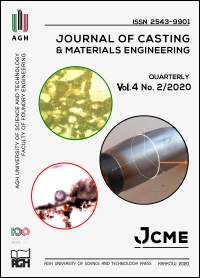A Casting Mould for Rapid Tube Hydroforming Prototyping
DOI:
https://doi.org/10.7494/jcme.2020.4.2.29Abstract
In recent years, hydroforming has clearly expanded its range of industrial applications due to the growing interest in products which combine high strength with low weight. A current limitation of this technology was its economically justified production volume since the costs of producing tools eliminates the possibility of using hydroforming technology in prototype and single part production. The paper presents a freshly patented solution that allows for single part hydroforming. The new technology combines traditional hydroforming machines with a new approach to tool production. The new rapid die is made quickly and cheaply. The use of materials known from the production of foundry moulds causes the die to deform during hydroforming, but it is a controlled deformation. Thanks to the use of numerical modelling, the deformation of the mould cavity is predicted and taken into account at the design stage. The article presents important issues that need to be considered in the design of this innovative process.Downloads
References
Kocańda A. & Sadłowska H. (2008). Automotive component development by means of hydroforming: A review. Archives of Civil and Mechanical Engineering, 8(3), 55–72. Doi: 10.1016/S1644-9665(12)60163-0.
Pinto M., Santos A., Teixeira P. & Bolt P. (2008). Study on the usability and robustness of polymer and wood materials for tooling in sheet metal forming. Journal of Materials Processing Technology, 202(1–3), 47–53. Doi: 10.1016/j.jmatprotec.
08.082.
Kochański A. & Sadłowska H. (2019). Patent no. PL424401. Sposób hydromechanicznego kształtowania profili cienkościennych i matryca do hydromechanicznego kształtowania profili cienkościennych. Biuletyn Urzędu Patentowego, Urząd Patentowy Rzeczypospolitej Polskiej. Wynalazki i Wzory Użytkowe, 17, 11.
Bast J., Kadauw A. & Malaschkin A. (2009). Optimising of Moulding Parameters for Green Sand Compaction by Computer Simulation and a New Compaction Measuring Device. International Journal of Metalcasting, 3(2), 55–65.
Waszkiewicz S. (1992). Wpływ błędów odwzorowania wnęki formy na dokładność wymiarową odlewów. Prace Naukowe – Politechnika Warszawska. Mechanika, z. 147. Warszawa: Wydawnictwa Politechniki Warszawskiej.
Dodge Woodson R. (2011). Appendix III – Foundry Sand Facts for Civil Engineers. In: Concrete Portable Handbook. Elsevier, 299–372.
Godula T. (1984). Metoda rozpoznawania warunków geologiczno-inżynierskich warstw karbońskich dla potrzeb projektowania kopalń oraz wyniki jej zastosowania w rejonie Bzie-Zebrzydowice [Doctoral Thesis]. Gliwice: Politechnika Śląska.
Sadłowska H. (2016). Strains in free tube hydroforming proc-ess. Journal of Manufacturing Technologies, 41(1), 7–11.
Sadłowska H., Jasiński C. & Morawiński Ł. (2020). Strain meas-
urements on the tube hydroforming testing machine. Archives of Metals and Metallurgy, 65(1), 257–263.


